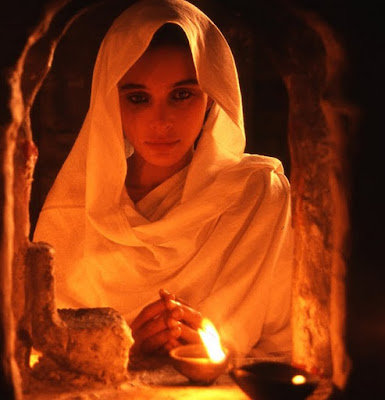G.P. Malalasekera, Dictionary of Pali Proper Names (Pali Tet Society, 1988-1973) edited by Ashley Wells, Dhr. Seven, Amber Larson, Crystal Quintero (eds.), Wisdom Quarterly
 |
| Uppalavanna Theri, the Buddha's chief female disciple foremost in magical powers. |
 |
| Modern Theravada Buddhist nun, Ven. Tathaloka, in California wilderness (bhikkhuni.net). |
 |
| Fragrant lotuses rise above their muddy pond water unstained (dingtwist.com) |
.
 |
| Lotuses arise from mire untainted (FM). |
She received the name "Uppalavannā" because her skin was the color of the heart or calyx of a blue lotus. When she came of age, kings and commoners from all over India sent messengers to her father asking for her hand in marriage.
Not wishing to offend any of them, he suggested that Uppalavannā should leave the world, that is, go forth and become a nun. Because of her past karma acting as a decisive support (upanissaya), she very willingly agreed and was fully ordained.
 |
| White lotuses in a pool (mrwallpaper.com) |
Then attaining to absorption (jhāna) thereby, she became fully enlightened along with the four special attainments call the analytical knowledges. She became particularly versed in the mystic power of transformation, shape shifting (iddhi vikubbana).
Magic powers
 |
| How could a lotus bud be the womb of a baby? The power of merit (passport-love.com). |
When the Buddha arrived at the gandamba-tree to perform the Twin Miracle, Ven. Uppalavannā offered to perform certain miracles herself, if the Buddha would allow it, but he declined, seeing great danger in disciples who possess them publicly exhibiting magical powers (ThigA.190, 195).
Later, at Jetavana, in the assembly of the Monastic Community (Sangha), the Buddha declared her to be a chief disciple, "foremost in supernormal (iddhi) powers (A.i.25), like Ven. Maha Moggallana among male disciples.
According to the Dhammapada Commentary (iii.211), the miracle which Ven. Uppalavannā volunteered to perform at the gandamba-tree, was the assumption of the form of a world ruler (cakkavatti), with a retinue extending for 36 leagues and the paying of homage to the Buddha, with all the ruler's followers, in the presence of the multitude.
The Verses of the Nuns (Therīgāthā, vv.234-5) contains several verses (gāthās of the theris or senior nuns, lit. monastic elders) attributed to her. Three of them were uttered in anguish by a mother who had been unwittingly living as her daughter's rival (or co-wife) with the man who later became the monk Ven. Gangātīriya.
Ven. Uppalavannā repeated these verses to help her reflect on the harm and vileness of sexual and sensual desires, which can reduce one to depravity. Two others are utterances of joy -- verses of uplift (udana) -- on the distinctions she had won; another records a miracle she performed before the Buddha, with his consent.
 |
| What's a pretty girl like you doing in a place... |
This conversation, which more or less identical with the foregoing, is recorded in S.i.131f, wherein she tells Mara that she has passed completely beyond his power and influence, his temptations and trickery.
Rape
 |
| Oh my goodness, the karmic consequences! |
 |
| No. Desist, fool, for what has this body to offer bu what great danger in your lust? |
It is said that as a result of this heinous crime he was swallowed up by the fires of Avīcī, the lowest of the hells known as the "waveless deep." From that time onwards, nuns were forbidden to live in Andhavana (DhA.ii.49f; the incident is referred to in Vin.iii.35), a forest grove used for monastic living and practice in the early forest tradition prior to there being formal nunneries and monasteries (viharas).
It is said (e.g., DhA.iv.166f) that this incident gave rise to the question of whether even fully enlightened being (arhats) enjoyed the pleasures of love and wished to gratify their passions. Why should they not? For they are not trees nor ant-hills, but living creatures with moist flesh.
The Buddha most emphatically declared that thoughts of lust never enter the hearts of arhats (fully liberated "saints" freed of all bondage and mental defilements).
Flesh
On another occasion, Ven. Uppalavannā came across some meat left behind in Andhavana, which was obviously meant for her. It was left by a kindhearted thief. Having prepared the meat, she took it to make an offering to the Buddha at the Bamboo Grove (Veluvana).
Finding him away on alms round, she left the meat with Ven. Udāyi, who was looking after the monastery (vihāra), to be given to the Buddha. But Udāyi insisted that Ven. Uppalavannā give him her inner robe as a reward for his services (Vin.iii.208f).
Mention is made of a pupil of Ven. Uppalavannā, who followed the Buddha for seven years, learning the monastic disciplinary code or Vinaya (Vin.ii.261).
The other chief female disciple
The Buddha declares that Ven. Khemā Theri (foremost in wisdom" like Ven. Sariputra among the monks) and Ven. Uppalavannā are the measure of his female disciples, and that the believing nun, if she would aspire perfectly, should aspire to be like them (A.i.88; ii.164; S.ii.236).
Past lives
In Padumuttara Buddha's time Uppalavannā saw a female disciple who was declared to be "foremost among those possessed of supernormal power," and wished for herself a similar rank in the dispensation of a future buddha.
In the time of Kassapa Buddha, she was one of the seven daughters of Kikī, king of Benares (Varanasi, India), and having done many good deeds, was reborn in a heavenly world.
Later, she was reborn in the human world and had to work for her living. One day she gave an offering to a nonteaching (pacceka) buddha, who had just risen from deep absorption (samādhi). She made an offering of a meal of fragrant rice in his bowl and covered it with a beautiful lotus.
She had prepared the meal for herself. The beautiful lotus she afterwards took back but again replaced it, asking the pacceka buddha's forgiveness. She expressed a wish that she should beget as many sons as there were grains of rice in her offering and that lotuses should spring up under her feet as she walked.
Lotus born
 |
| Red and blue lotus blossom, symbolic flower of the East (devwijewardane) |
.
 |
| Born in a lotus blossom |
- Sophal1 explains that the Abhidharma describes three modes of conception: womb born, born of flowers, fruit, or tree-hollows, and spontaneously born [apparently of mind powered by karma with no intervention of parents].
The king's other wives became very jealous of her beauty, and when the king was away to quell an uprising of border tribes, they concealed in caskets her many sons, chief of whom was Prince Mahāpaduma.
They hid everyone born to Padumavatī and told the king that Padumavatī was a nonhuman who had given birth to a log of wood.
Padumavatī was sent away in disgrace, but later through the divine intervention of Sakka (King of the Devas), their deception was exposed, and Padumavatī regained all of her former power and glory. (Her temporary downfall was due to her having withdrawn her lotus gift to the pacceka buddha).
Later, when Prince Mahāpaduma and his brothers became pacceka buddhas, Queen Padumavatī died of a broken heart and was reborn in a village outside Rājagaha (modern Rajgir, India, a royal city surrounded by a ring of seven hills where Vulture's Peak is located).
There some of the pacceka buddhas who had been her sons discovered her, and they all came to a meal offering at her house. At the conclusion of the meal, she offered them blue lotuses and expressed the wish that her complexion should be like the calyx of the blue lotus.
This account is a summary of the Therīgāthā Commentary, pp.182ff; AA.i.188ff; but see also DhA.ii.48f.
The Collection of Monastic Stories (Apadāna) account of the past lives of Uppakavanna differs from the above in several details (ii.551, but vv.1-15 quoted in the Therigatha differ from those in the Apadāna and agree with the Therigatha account).
Reptilian
 |
| Naga princess (allexandramonica) |
The Apadāna also mentions Uppalavannā's birth as the daughter of a banker of Benares in the time of Vipassī Buddha. She gave great alms to the Buddha and monastic disciples and made offerings of lotuses.
She was the second daughter of Kikī, and her name was Samannaguttā. In her next rebirth she became the ravishing daughter of Tirītavaccha of Aritthapura. In her last rebirth she became an arhat within a fortnight (two weeks) of her ordination as a nun.
Uppalavannā's name occurs several times in the Jātakas, the Rebirth Tales of the Buddha:
In the Kharādiya Jātaka (J.i.160) she was a deer, the sister of the Bodhisatta (the Buddha-to-be).
Jataka Tales (Rhys Davids) - In the Tipallatthamiga Jātaka (J.i.164) she was the mother of Rāhula (the Buddha's son), then reborn as a stag.
- She is identified with the old woman, the foster-mother of Ayyakālaka (J.i.196),
- with the queen Mudulakkhanā (J.i.306),
- the female Brahmin in the Sārambha Jataka (J.i.375),
- the courtesan in the Kurudhamma Jataka (J.ii.381),
- the Brahmin's daughter (and sister of Rāhula) in the Dhonasākha Jataka (J.iii.168),
- Siridevī in the Sirikālakanni Jataka (J.iii.264),
- the goddess in the Bhisapuppha Jataka (J.iii.310),
- Manoja's sister in the Manoja Jataka (J.iii.324),
- the ascetic's daughter in the Kumbhakāra Jataka (J.iii.383),
- the deity in the Jāgarajā Jataka (J.iii.405), in the Sankha Jataka (J.iv.22), and in the Kiñchanda Jataka (J.v.11),
- the sister in the Bhisa Jataka (J.iv.314),
- Sutanā in the Rohantamiga (J.iv.423),
- the younger sister in the Jayaddisa Jataka (J.v.36),
- Kundalinī in the Tesakuna Jataka (J.v.125),
- Ummadantī in the Ummadantī Jataka (J.v.227),
- Hiridevatā in the Sudhābhojana Jataka (J.v.412),
- the goddess of the parasol in the Mūgapakkha Jataka (J.vi.29),
- the ocean spirit in the Mahājanaka Jataka (J.vi.68),
- the goddess in the Sāma Jataka (J.vi.95),
- Selā in the Khandahāla Jataka (J.vi.157),
- Accimukhī in the Bhūridatta Jataka (J.vi.219),
- Bherī in the Mahā-ummagga Jataka (J.vi.478), and
- Kanhajinā in the Vessantara Jataka (J.vi.593).
It was Ven. Uppalavannā who ordained Anojā and her companions by the express wish of the Buddha (AA.i.178).


































































































































































































































No comments:
Post a Comment